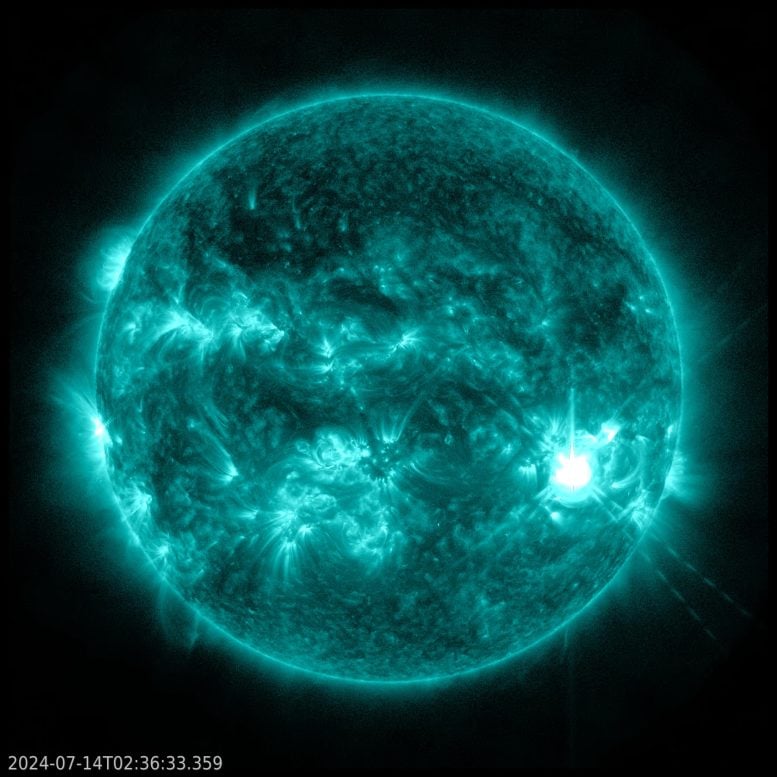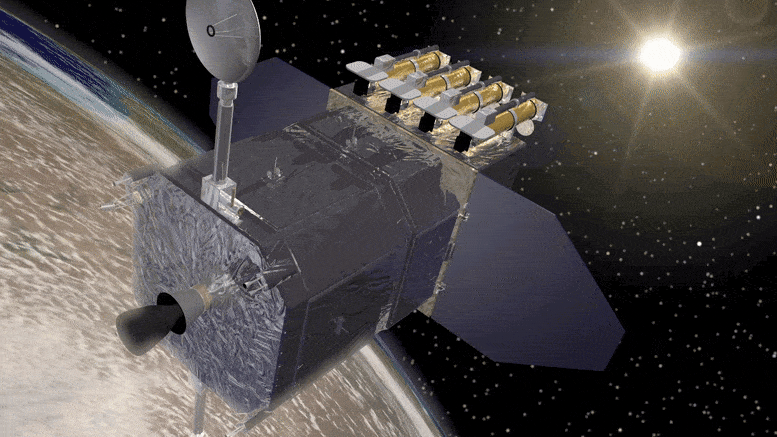
NASA’s Solar Dynamics Observatory captured this image of a solar flare — seen as the bright flash on the right – on July 13, 2024. The image shows a subset of extreme ultraviolet light that highlights the extremely hot material in flares and which is colorized in teal. Credit: NASA/SDO
On July 13, 2024, the sun emitted a powerful X1.2 class solar flare, which reached its peak intensity at 10:34 p.m. EDT. It was captured by NASA’s Solar Dynamics Observatory, which continuously monitors the Sun.
Solar flares are intense bursts of radiation coming from the release of magnetic energy associated with sunspots. Flares are our solar system’s largest explosive events and are seen as bright areas on the sun. Their energy can reach Earth within minutes and cause disturbances to the electromagnetic field.
The classification of solar flares is based on their brightness in the X-ray wavelengths observed by satellites. These classes are labeled as A, B, C, M, and X, with A being the smallest and X the most intense. Each class has a tenfold increase in energy output than the preceding one. Within each letter class, there is a finer scale from 1 to 9, which provides more details about the flare’s strength. For instance, an X1 flare is the lowest in its class but is still ten times more powerful than an M1 flare.
X-class flares are major events that can trigger planet-wide radio blackouts and long-lasting radiation storms. Monitoring and understanding solar flares is crucial for anticipating and mitigating their effects on satellite communications, navigation systems, and power grids.

This animation of the Solar Dynamics Observatory shows it above the earth as it faces toward the Sun. SDO is designed to help us understand the Sun’s influence on Earth and Near-Earth space by studying the solar atmosphere on small scales of space and time and in many wavelengths simultaneously. Credit: NASA/Goddard Space Flight Center Conceptual Image Lab
NASA’s Solar Dynamics Observatory (SDO) is a mission dedicated to observing the Sun and helping scientists understand its influence on Earth and near-Earth space. Launched on February 11, 2010, SDO is part of NASA’s Living With a Star (LWS) program, which aims to develop the scientific understanding necessary to address those aspects of the connected Sun-Earth system that directly affect life and society.
SDO’s primary goal is to study the solar atmosphere on small scales of space and time and in many wavelengths simultaneously. The observatory is equipped with a suite of instruments that provide observations leading to a more complete understanding of the solar dynamics that drive variability in the Earth’s environment. These instruments include the Atmospheric Imaging Assembly (AIA), which captures images of the solar atmosphere in multiple wavelengths to link changes in the surface to interior changes. The Helioseismic and Magnetic Imager (HMI) maps the solar magnetic fields and peers beneath the sun’s opaque surface using helioseismology. The Extreme Ultraviolet Variability Experiment (EVE) measures the sun’s ultraviolet output, which is a key driver of space weather.
By continuously observing the Sun in high resolution and across multiple wavelengths, SDO provides insights into solar activities like solar flares, coronal mass ejections (CMEs), and other phenomena that can have profound impacts on Earth. This ongoing monitoring is crucial for advancing our understanding of the Sun’s complex and dynamic behavior.









Be the first to comment on "X1.2 Event: Decoding the Sun’s Latest Megaflare"